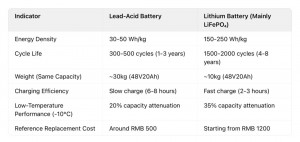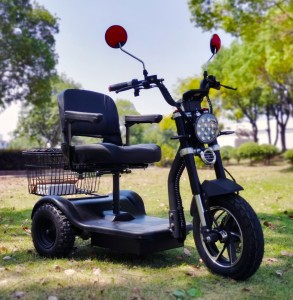Battery Technology Analysis: Lead-Acid/Lithium-ion Battery Options to Meet Different Regional Range Needs
I. Core Technology: Performance Competition Between Lead-Acid and Lithium-ion Batteries
1. Differences in Basic Characteristics
2. Safety Protection Technology
Lead-Acid Battery: Uses dilute sulfuric acid as electrolyte, exhibiting strong thermal stability and resistance to explosion at extreme temperatures. Maintenance can be performed at ordinary repair shops. Wellsmove employs leak-proof gel technology to further reduce usage risks.
Lithium-ion Battery: Equipped with a BMS battery management system compliant with the new GB43854 national standard, achieving precise monitoring of voltage, current, and temperature. Automatic power-off occurs when the temperature exceeds 50℃, and it has passed needle penetration and crushing safety tests.
II. Global Adaptability: Precise Matching Based on Regional Needs
1. Southeast Asian Market: Lead-Acid Batteries’ Cost-Effective Advantage
Demand Characteristics: Rural cargo transport, short-distance high-frequency use, with a focus on ease of maintenance and low initial costs. **Adaptation Logic:** Lead-acid batteries cost only 1/3 of lithium batteries, with a residual value of 200-500 RMB, and require no dedicated charging equipment. The Wellsmove 60V 58Ah lead-acid battery model offers a range of up to 100 kilometers, suitable for urban and rural transportation scenarios in countries like Indonesia and Vietnam.
2. European Market: Lithium Batteries Drive Long-Range Demand
**Demand Characteristics:** Intercity commuting, strict environmental regulations, and high requirements for range and lightweight design.
**Adaptation Logic:** Lithium batteries have 3-5 times the energy density of lead-acid batteries. A 48V 23Ah lithium battery model offers 20%-30% longer range than a lead-acid battery of the same capacity, reaching 100 kilometers. The Wellsmove 60V 120Ah lithium battery model boasts a range exceeding 200 kilometers, meeting the long-distance commuting needs of Germany and France, and complies with EU environmental recycling standards. 3. North American Market: Dual Batteries for Diverse Scenarios
Demand Characteristics: Cold-weather performance is required in the low-temperature northern regions, while durability for high-frequency use is emphasized in the south.
Suitability Logic: Lead-acid battery models are recommended for cold regions such as Canada, with only a 20% range reduction at -10℃; lithium iron phosphate battery models are available in the southern United States, with a cycle life of up to 2000 cycles and a total cost 12%-18% lower than lead-acid batteries over 5 years.
4. African Market: Policy-Driven Lead-Acid Battery
Demand Characteristics: Government subsidies favor low-cost models, and service network resources are limited.
Suitability Logic: Referring to the domestic “Rural Revitalization Subsidy” model, lead-acid models can be combined with local subsidies. The Wellsmove 64V54Ah lead-acid model has an 8% cost reduction after subsidies, and its 100km range is suitable for daily commuting scenarios in countries such as Nigeria.
III. Dealer Value: Dual Empowerment through Cost and Policy
1. Profit Margin Calculation (Based on a 5-year usage cycle)
2. Compliance and After-Sales Support
All models meet target market access standards: China GB17761-2024 new regulations, EU CE certification, and US UL certification.
Separate customs clearance service for batteries is provided to circumvent lithium battery transportation restrictions; lead-acid batteries support used product recycling and rebates, increasing end-user repurchase rates.
IV. Wellsmove Technology Advantages
Customizable Capacity: Battery specifications can be adjusted from 48V to 72V according to dealer needs, with a range covering 50-230 kilometers.
Intelligent Adaptability: Lithium-ion models come standard with a fast-charging module, while lead-acid models can be equipped with solar charging panels, adapting to areas with weak power infrastructure.
Warranty Policy: 18-month warranty for lead-acid batteries and 5-year warranty for lithium batteries, far exceeding the industry average.
Post time: Nov-05-2025





